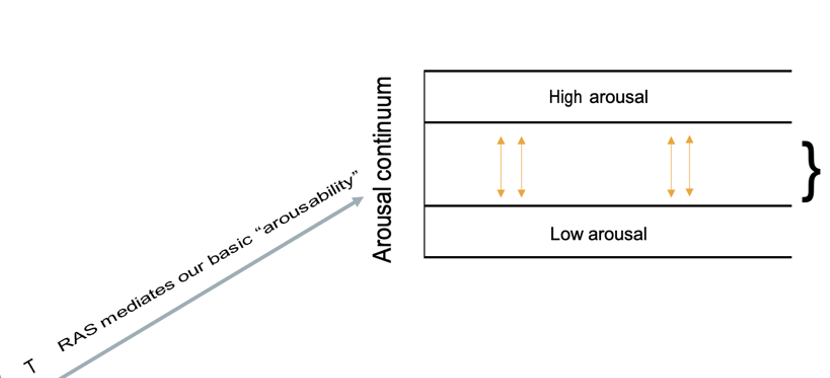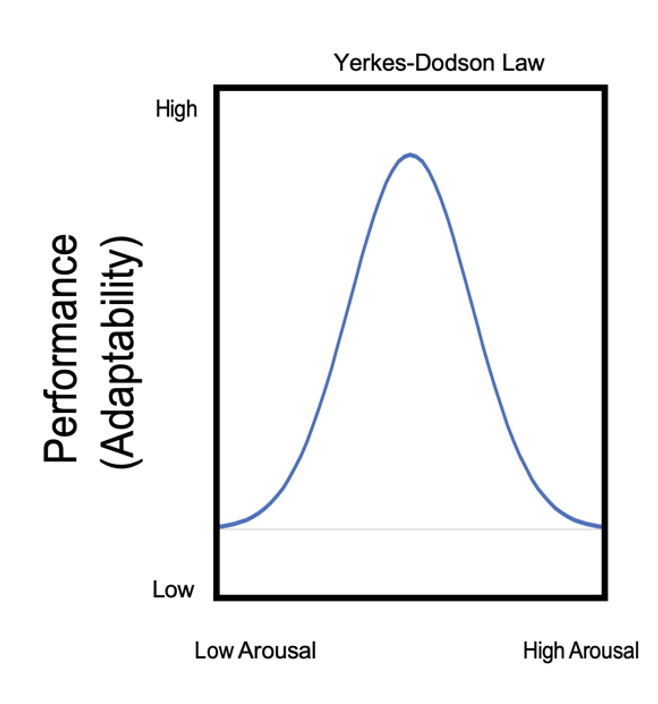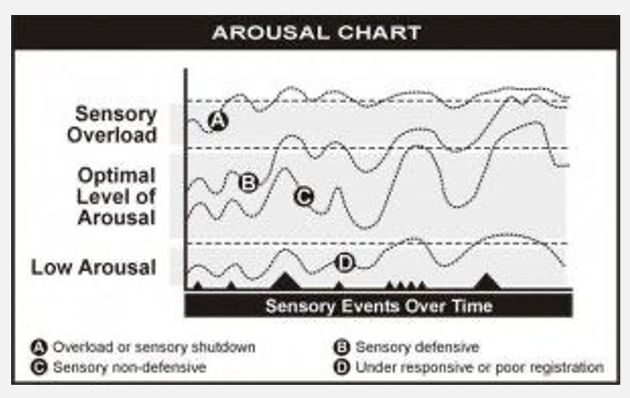PEDs II Exam II
1/86
There's no tags or description
Looks like no tags are added yet.
Name | Mastery | Learn | Test | Matching | Spaced |
|---|
No study sessions yet.
87 Terms
Regulation
Ability to adapt our neurological arousal, emotional state, motor activity, attention, and behavior to meet our own needs and the demands of the situation
Interoception System
Our awareness of sensations originating inside of our body, such as hunger, a full bladder, feeling tired, or ill; also includes recognition of body feelings as they relate to felt emotions, such as heat from anger, heaviness from sadness, etc.
Primarily though to relay signals about the body’s internal state
Olfactory
Sense of smell
Proprioceptive System
Unconscious awareness of sensations coming from one’s joints, muscles, tendons, and ligaments; the “position sense”. Underlies one’s ability to place body parts in a position in space
Gustatory
Sense of taste
Tactile System
Information taken into the body through the sense of touch. Can be through deep pressure receptors or light pressure receptors
Vestibular System
Comprised of structures in the inner ear that give us information about movement and the position of our head in relation to gravity
Sensory Systems
Vision
Hearing
Gustatory
Olfactory
Tactile
Proprioception
Vestibular
Interoception
How does the brain use sensory information?
State Regulation
Emotional Regulation
Motor control
To support executive functions and cognition
Enabling communication and social interactions
Foundation for behavior
Jean Ayers’ Contributions to Sensory Integration
Created sensory integration (SI) theory
Developed assessments, including the Sensory Integration and Praxis Test (SIPT) to investigate sensory processing
Jane Ayer’s definition of Sensory Integration
The neurological process that organizes sensations from the environment and makes it possible to use the body effectively in the environment
Jane Ayers’ Principles of Sensory Integration Intervention
Purposeful activity
Child directed and intrinsically motivated
Incorporating use and influence of sensory experiences
Just right Challenge
Adaptive Response (successful response to an environmental change)
Ayers’ Sensory Integration (ADI Fidelity measure
Developed in 2014 to ensure that SI therapy adheres closely to SI theory
Strengthened the ability to research the effectiveness of SI interventions
What provides the foundation for all higher-level skills?
Regulation
Reticular Activating System
Responsible for mediating arousal
Arousal Continuum
We are most adaptable when we are in a “window” of midrange

Relationship between arousal and performance
Only medium levels of arousal provide suitable conditions
Overarousal and underarousal interfere with performance particularly in complex tasks

Sensory Events and Arousal
Sensory events (aka sensory stimuli/experiences) impact our arousal, which influences regulatory capacities
How each individual responds to the same sensory event varies based on their nervous system (orange line: someone able to maintain adaptable arousal, black line: person who becomes overstimulated and is in a high arousal state → more stimulation can causes a shutdown state)

Arousal Chart
Represents typical relationships between an individuals’ sensory processing and their arousal


Sensory Defensive (B)
An accumulation of sensory events throughout the day is likely to send them into “sensory overload” (aka high arousal OR “shutdown")

Sensory Non-Defensive (C)
Has sensory processing within the typical range, this person is more likely to remain regulated throughout the day.
Sensory Modulation
Process of enhancing or dampening sensory input subconsciously for the purpose of maintaining regulation/harmony of the nervous system
What is the primary purpose of sensory modulation?
Maintain regulation
Sensory Discrimination
Provides information that allows us to distinguish characteristics of sensory input
What is the primary purpose of sensory discrimination?
Skill development
High Threshold
Aka Low registration
Takes a lot of sensory input to register in the child’s nervous system
Passive Behavioral Response for High Threshold
Miss (or don’t notice) available sensory input
Spacey, clumsy
Under-responsive or slow to response
Able to focus in distracting environments
Flexible, comfortable in a wider range of environments
Active Behavioral Response for High Threshold
Enjoys sensory-rich environments
Likely to create/seek sensation
Trouble tolerating low stimulus environments (easily bored)
Low Threshold
Aka sensory sensitive
Just a small amount of sensory input may trigger a response from child
Passive Behavioral Response for Low Threshold
Highly aware of surroundings
Distractible by sensory input
Notice things other people don’t notice
Easily respond to sensory stimuli
Active Behavioral Response for Low Threshold
Overwhelmed by sensory rich environments
Intentional withdrawal or blocking of sensation (attempt to minimize sensation)
Prefer structured supportive environments (with more predictable sensory stimuli)
To understand how a child’s sensory processing is impacting their ability to interact with their environment, we must become __________ ____________.
Careful observers
Characteristics of being “tipped toward” safety
Regulation → engagement
Engaged
Adaptable
Fun/creative
Characteristics of being “tipped toward” protection
Fight, flight, fright, fawn
How can you promote “felt safety” and help with sensory modulation?
By using connection and coregulation
Relational interventions like DIR, RDI, TBRI are useful for learning the skill of connecting
For a child with low reactivity (aka low registration, aka under responsive), you would ___________ sensory input
Increase
For a chid who is in shutdown (has been bombarded by too much input), you would ___________ sensory input
Decrease
If a child who appears “low reactive” or “low registration” has a normal pain tolerance (e.g., cries/notices when they get hurt), they most likely are
Low reactive (aka low registration, aka under responsive)
If a child has a very high pain tolerance (e.g., usually doesn’t notice when they get hurt) they are most likely in a ___________ state
Shutdown
Sensory discrimination is the foundation for what functions?
Body scheme development
Bilateral integration and sequencing
Postural-ocular control
Praxis
Body scheme development
Unconscious map of physical body stored in the brain
Bilateral integration & sequencing
Coordination of the two sides of body to perform synchronized and sequential movements
Postural-ocular control
Motor control of body position and eye movement
Praxis
Ability to conceptualize and organize novel actions (have idea, plan, execute)
Specific patterns of sensory discrimination dysfunction can be examined through …..
Standardized assessments (e.g., SIPT, EASI)
Treating problems with sensory discrimination
Assess sensory modulation and understand how it contributes to problems with discrimination
Set up the “just right challenge”: understand what is intrinsically motivating to the child and offer opportunities for enhanced sensory exploration (don’t force it!) We want the child to enjoy the experience and feel successful
Common diagnoses of children who have challenges in sensory integrative processing
Autism
Children with prenatal drug exposure history
ADHD
People with cognitive deficits
People with learning disabilities
People with genetic conditions
Key words important to sensory integration therapy
Child “buys in”
Child-directed
“Artful vigilance”
“Just Right Challenge”
Adaptive Response
Inner Drive
“Scaffolding”
Scaffolding
How therapist adjusts and controls task elements that are beyond child’s current skills
Patterns of Adaptation for Receptors and Stimuli
Habituation
Sensitization
Habituation
Typical response to repeated exposure to sensory stimuli (e.g., not noticing a tag in their shirt a few minutes after getting dressed)
Sensitization
Repeated administration of a stimulus results in the progressive amplification of a response
Someone has problems with sensory modulation (e.g., becoming more and more irritated by the tag in their shirt)
Features of sensory stimuli
Frequency: how often
Intensity: how strong
Duration: how long
Importance and Functions of Somatosensory System
Receptors of the self
Gives us our boundary and informs our understanding of self vs other
Sensory system of attachment and socialization
Provides a lot of inhibition for the CNS
Provides information for body scheme
Provides detailed information for skilled use of objects and interactions with the world
Provides information for postural and motor control
A foundation for praxis
Provides the valence coding, which is the basis of our emotional experience
Provides a foundation for language and social pragmatics
Types of Somatosensory Receptors
Exteroceptors
Proprioceptors
Interoceptors
Exteroceptors
Provide information from outside of our body
Tactile receptors
Proprioceptors
Provide information about joint and body movements, position of the body (or body segments) in space
Joint receptors
Muscle and tendon receptors
Interoceptors
Provide information from inside our body
Sensations from internal organs
Mechanoreceptors, baroreceptors, chemoreceptors, thermoreceptors
C fibers: pain, including emotional pain
Sensory modulation circuitry travels in the ______________ ___________
Anterolateral system
Sensory discrimination circuitry travels in the ________ ____________.
DCML pathway
Sensory Modulation: Somatosensory
Circuitry that enhances and dampens sensations
Purpose: regulation
Travels in the Anterolateral System
Detects:
valence of the stimulus
temperature, itch, pain, and affective touch
condition of our body
Sensory Discrimination: Somatosensory
Takes in the detail of information
Purpose: use/skill
Travels in the Dorsal Column Medial Lemniscal system
Detects stimulus features:
Quality (texture, shape, weight, etc.)
The location of the stimulus
Intensity
Detects body position
Which sensory system is made up of exteroceptors and is responsible for our sense of touch?
Tactile System
Functions of the Tactile System
Basis of the valence coding
Provides earliest form of communication
Sets the stage for bonding and social attachment
Creates a lot of inhibition in the nervous system which can help with down regulation
Provides us with information to create our body scheme
Provides the basis for motor control (hand and oral motor skills)
Activates some early, important reflexes (rooting, sucking, grabbing)
Provides us with information about the boundary of our body, setting the stage for our sense of self
Provides the underlying info for self/other understanding
Provides perceptual awareness of size, shape, weight, temperature
Provides info about the spatial location of our body relative to things in the environment
Contributes to language and communication
Integral to praxis
Functions of Interoception
Basis for the affective tipping point/valancing mechanism that tips because of physical pain and/or emotional pain
Affective touch perception
Homeostasis
Hunger/thirst
Nausea
Bowel and bladder
Heartbeat
Air hunger
Low blood sugar
Informs us of the condition of our body including our fascia
Gives us affective coding
Foundation of our emotional experience
Functions of the Vestibular System
Information taken in by receptors in our inner ear:
Where we are in space (in relation to gravity)
If we are upright, tilted, or upside down
How fast/slow we’re going
In what direction we’re traveling
If you are still moving, or have stopped
Which sensory system has a role is both modulation and discrimination
Vestibular system
Vestibular Modulation
Regulates arousal, attention, autonomic (ANS), affect (emotional), and action (motor)
Supports social functions, executive functions, cognition, and sense of self
Vestibular Discrimination
Detail of information for purpose of use/skill
Awareness of gravity, postural control, balance, praxis, bilateral control, cognition
If a child has trouble with vestibular modulation, they will either ______-__________ vestibular input or ______- ____________ vestibular input.
Over-register, under-register
What happens when a child has trouble with vestibular modulation and they over-register vestibular input?
They will be sensitive to movement and likely cautious
What happens when a child has trouble with vestibular modulation and they under-register vestibular input?
The child will be less sensitive to movement and be constantly in motion to get extra vestibular input to help regulate themselves
Gravitational Insecurity
Refers to discomfort with movement that is rooted in vestibular processing challenge
Identified by Jean Ayers
You can assess vestibular processing using what?
Sensory questionnaires (SPM-2, SP-2) or by assessing Post-Rotary Nystagmus (eye movements after spinning)
How can you treat vestibular dysfunction for sensory modulation?
Provide connection and coregulation
Observe ANS signs
Address regulation
Deep pressure touch and proprioception to provide regulation
Engage a child’s motivation through affective engagement
Use music or rhythm to facilitate regulation
How can you treat vestibular dysfunction for sensory discrimination?
Keep modulation in mind at all times
Provide opportunities for exploration with enhanced sensation
Consider the direction of the movement (linear, rotary, oblique)
Consider the rate and rhythmicity
Pair vestibular movement with other sensory systems for the purposes of skill (balance or visual motor activities)
Must address “low route” motor skills and the processing of vestibular info before targeting praxis
Use music or rhythm to facilitate rhythmicity
How can the vestibular system be used as a strength in treatment?
Use rhythm and movement to facilitate regulation
Use enhanced vestibular input to elicit postural and motor control
use enhanced movement to facilitate oculomotor control
Use movement for engagement and fun
Signs of vestibular overload
Flushing or becoming pale
Change in respiration (yawning, increased breath rate)
Lethargy
Excitation
Vomiting
How do you counteract vestibular overload?
Heavy Work (pushing pulling)
Deep pressure
Jumping, running
Blowing activities
Ice cubes placed in palms of hands and then placed on back of neck and then on temples
General purpose or point of Sensory Processing/Integration intervention
Clinical reasoning and treatment planning should happen outside of the session. Within the session, the most important thing that you can do is be present in the moment. In order to be present with the child, you may have to work on your own regulation and self-compassion
Observe and be curious about what happens when you offer opportunities and make adjustments
“If it works, it’s treatment. If it doesn’t, it’s assessment” Regie Boehme
How do you treat problems with sensory modulation
Pay attention to affective valence tipping point
Provide connection/notice whether the child can effectively use coregulation for the purpose of regulation
Notice patterns of response relative to the situation
Notice how regulation capacities affect sensory modulation
Distinguish between low reactivity and shutdown. DO NOT try to desensitize or increase tolerance if the client is experiencing the activity with a negative valence
Address physiological needs
Address regulation with sensory strategies.
Help family to understand their child’s sensory preferences and how they are a match for the family/occupations
Reduce stressors
Modify the task or environment
Build resilience
How do you treat problems with sensory discrimination?
Assess modulation (regulation) and it’s contribution to discrimination first
Assess and address specific discrimination issues in the sensory systems. Offering opportunities for enhanced sensory exploration
Tap into internal motivation
Set up the environment to provide just right challenge
We want to offer opportunities for exploration in a _____ ________! We do not force a child to engage in activities that are uncomfortable/stressful to them
Safe context
What is important to keep in mind when treating proprioceptive dysfunction?
Postural security and heavy work
What kind of practices are important for treating interoceptive dysfunction?
Focused attention (e.g., mindfulness)
What is important to consider and keep in mind when treating vestibular dysfunction?
The direction, rate, and rhythmicity of movement
What is the most powerful tool we have to make positive change.
Therapeutic relationship